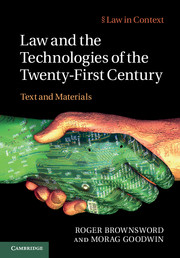Book contents
- Frontmatter
- Contents
- Acknowledgements
- Miscellaneous Frontmatter
- Abbreviations
- Table of cases
- Table of statutes and other public documents
- Part I General introduction
- Part II Regulatory prudence and precaution
- Part III Regulatory legitimacy
- 8 Key boundary-marking concepts
- 9 Human rights as boundary markers
- 10 A look at procedural legitimacy: the role of public participation in technology regulation
- Part IV Regulatory effectiveness
- Part V Regulatory connection
- 15 Regulatory connection I: getting connected
- 16 Regulatory connection II: disconnection and sustainability
- Concluding overview
- Index
- References
15 - Regulatory connection I: getting connected
from Part V - Regulatory connection
Published online by Cambridge University Press: 05 August 2012
- Frontmatter
- Contents
- Acknowledgements
- Miscellaneous Frontmatter
- Abbreviations
- Table of cases
- Table of statutes and other public documents
- Part I General introduction
- Part II Regulatory prudence and precaution
- Part III Regulatory legitimacy
- 8 Key boundary-marking concepts
- 9 Human rights as boundary markers
- 10 A look at procedural legitimacy: the role of public participation in technology regulation
- Part IV Regulatory effectiveness
- Part V Regulatory connection
- 15 Regulatory connection I: getting connected
- 16 Regulatory connection II: disconnection and sustainability
- Concluding overview
- Index
- References
Summary
Introduction
One of the distinctive challenges presented to regulators by rapidly developing modern technologies is, quite simply, the pace of their development. How do regulators get connected to these technologies, and how do they stay connected? As John Perry Barlow famously remarked:
Law adapts by continuous increments and at a pace second only to geology in its stateliness. Technology advances in … lunging jerks, like the punctuation of biological evolution grotesquely accelerated. Real world conditions will continue to change at a blinding pace, and the law will get further behind, more profoundly confused. This mismatch is permanent.
If Barlow is correct, at any rate in the context of emerging technologies, regulators will be challenged as they attempt to make and then to sustain the connection between the regulatory environment, the technology in question, and its applications.
Where a technology or a novel application emerges, it will sometimes be lamented that there is, so to speak, a regulatory void, this meaning that there is no bespoke legal guidance on the issue. However, even if there is no bespoke legal guidance, and even though regulatees might be unclear as to their legal position, we should not overstate the problem. First, the regulatory environment might have clear default signals as to the appropriate action where the legal position is unclear; in some cases, the signal might be that, without clear legal authorisation, one should not proceed; or, to the contrary, it might be that it is permissible to proceed in such circumstances. Second, even in the absence of dedicated and specific legal guidance, there are likely to be various legal provisions that have some application. For example, there are likely to be some ex ante safety provisions in place (although, quite possibly, needing some adjustment); and, there will be ex post general doctrines such as product liability and informed consent that will provide some protection to those who might be injured by dangerous goods or procedures.
- Type
- Chapter
- Information
- Law and the Technologies of the Twenty-First CenturyText and Materials, pp. 371 - 397Publisher: Cambridge University PressPrint publication year: 2012

